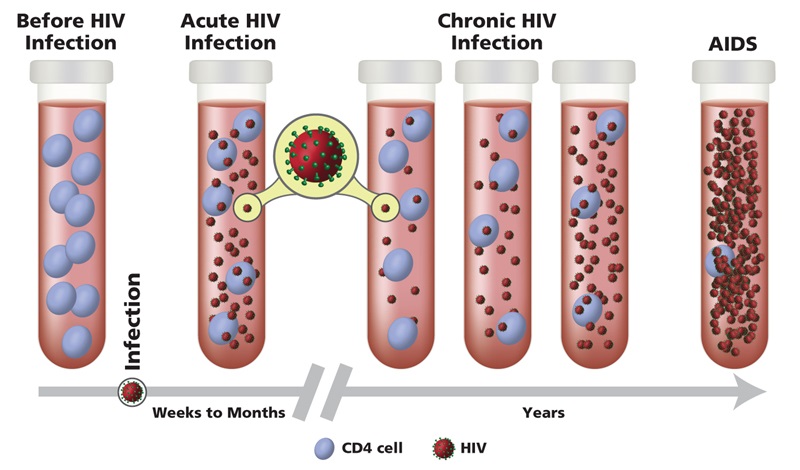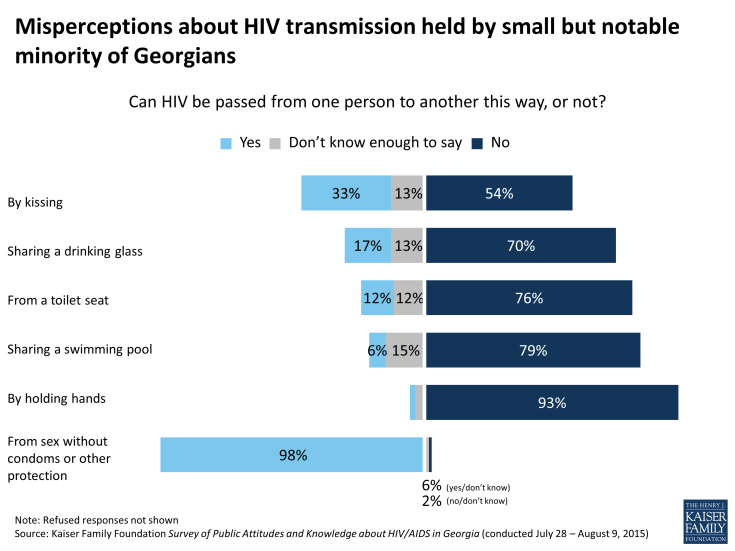On June 5 1981, the CDC published in its Morbidity and Morality Weekly Report a discussion of 5 cases of a rare lung infection known as Pneumocystis carinii pneumonia (PCP) in previously healthy gay mean. This is the first official report of what’s known today as Acquired Immunodeficiency Syndrome (AIDS).
AIDS is the final stage of Human Immunodeficiency Virus (HIV) infection. There are three stages of HIV infection: Acute Infection, Chronic Infection, and AIDS. During Acute Infection, people have flu-like symptoms while the HIV virus multiplies rapidly throughout the body attacking the highly important CD4 T-Cells of the immune system. Since HIV levels in the blood are very high, an individual in this stage is highly transmissible. During Chronic Infection, HIV continues to multiply but at such low levels that individuals may not have any symptoms. AIDS is the most severe stage of HIV infection as the severely weakened immune system leaves the body unable to fight off opportunistic infections-infections which usually pose only a harmless nuisance, such as the common cold. Once diagnosed with AIDS, individuals survive about 3 years without treatment.
It’s largely accepted that HIV evolved from the closely related Simian Immunodeficiency Virus (SIV), which spilled over to humans from Central African primates, further highlighting the dangers of the African bushmeat trade discussed in my previous post on the Ebola Epidemic. From Africa, HIV spread to the Western Hemisphere where it initially broke out in the gay community, whose lifestyle of casual, unprotected, multi-partner sexual activity allowed HIV to spread explosively. HIV transmits through bodily fluids-blood, semen, rectal fluids, vaginal fluids, and breast milk-meaning it can spread through unprotected sex, from mother to child via breast milk, through the sharing of drug needles, and from contaminated blood transfusions.
As of 2020, more than 36 million people worldwide have died of AIDS since the start of the pandemic. Although with proper treatment an HIV diagnosis is no longer a death sentence, there are still 37.7 million people worldwide living with HIV/AIDS as of 2020 who still experience the stigma of HIV diagnosis which dates to the pandemic’s beginning.
Since initial AIDS deaths were among gay men, the official name until 1982 for AIDS was ‘GRID’, or Gay-Related Immune Deficiency. With this early misstep, AIDS was quickly attached to what was, at the time, widely considered a sinful lifestyle. News broadcasts reporting on the pandemic used terms such as “gay cancer” and the “gay plague” as many openly blamed the afflicted, believing it was God’s punishment for living in sin. When it was shown that nearly half the people with AIDs weren’t homosexual men, homosexuals were further isolated as lepers capable of endangering “normal people” with their sin.
This stigma was further bolstered by the misinformation on HIV transmission. Many thought, and still to this day believe that HIV can be contracted by touching an HIV-positive individual or surfaces the individual has touched. The responsibility for HIV misinformation is largely attributed to Dr. Anthony Fauci, the Director of the National Institute of Allergy and Infectious Diseases, who speculated throughout the AIDS pandemic that close contact with AIDS-afflicted individuals could result in infection. The below interview of Dr. Anthony Fauci is from May 1983, where he speculates close contact is a method of HIV transmission despite the CDC’s certainty of all HIV transmission methods by January 1983.
Where, oh where, did they get an idea like that? https://t.co/lUFnlXVyBL pic.twitter.com/roAxd8DCgz
— Kennedy W. Roberts 🌪️ (@KennedyWRoberts) November 9, 2021
The AIDS pandemic highlights the dangers of unfounded speculating and theorizing at times of high societal tension, especially during outbreaks of novel, deadly diseases. Such unproven speculations from trusted sources add fuel to the fire, resulting in long-lasting and impactful misinformation ingrained in society even decades later.

